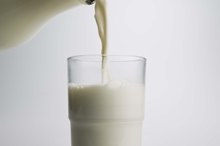Symptoms of a Vitamin D Deficiency in Adults
Adults require anywhere from 600 to 800 international units of vitamin D per day, but it’s a micronutrient found naturally in few food sources. Fortified foods provide most of the vitamin D in the American diet, according to the Office of Dietary Supplements, and some people can get enough through exposure to sunlight 7. A vitamin D deficiency is fairly common, but you might mistake its symptoms for another condition – if you experience any symptoms at all 2.
Prevalence of a Deficiency
According to an article published in “Mayo Clinic Proceedings” in August 2010, vitamin D deficiency is much more prevalent than it has been in the past 1. Between 1988 and 1994, 60 percent of Caucasian adults had sufficient vitamin D; between 2001 and 2004, this number had dwindled to 30 percent. In black adults, vitamin D sufficiency dropped from 10 percent to 5 percent during the same time span.
Physical Symptoms
Signs & Symptoms of Vitamin B-12 & Vitamin D Deficiencies
Learn More
You might not realize that you have a vitamin D deficiency, says the Vitamin D Council, as symptoms can be very vague, including fatigue and general aches and pains, if they manifest at all 26. But certain signs are more common than others -- manifestations of a deficiency can include lower back pain, throbbing bone pain marked by feelings of pressure over the sternum or tibia and muscle weakness. These symptoms sometimes lead to a misdiagnosis of fibromyalgia, chronic fatigue syndrome or arthritis, according to American Family Physician.
Mental Symptoms
If you’re experiencing hallmark symptoms of depression, including decreased energy, irritability, loss of interest in activities and persistent sad or anxious feelings, a vitamin D deficiency could be blame. Two studies published in 2013 – one in “Molecular Psychiatry” and another in the “British Journal of Psychiatry” -- linked depression to a low vitamin D level 45. Both studies, however, noted that further research should be done. If you’re feeling symptoms of depression, speak with your health care provider about the best treatment and potential causes.
- If you’re experiencing hallmark symptoms of depression, including decreased energy, irritability, loss of interest in activities and persistent sad or anxious feelings, a vitamin D deficiency could be blame.
Testing for a Deficiency
B12 & Migraines
Learn More
Get to the bottom of your symptoms by asking your doctor for a vitamin D test, known as the 25(OH)D test 2. Your results will come back measured as nanograms per milliliter. Although the definition of a deficiency varies among organizations, the 2010 “Mayo Clinic Proceedings” article reports that an insufficiency is often categorized as under 30 nanograms per milliliter and a deficiency as less than 20 nanograms per milliliter 1. The Vitamin D Council recommends a level of 50 nanograms per milliliter 26. If your results return as insufficient or deficient, speak with your physician about the best course of treatment.
Related Articles
References
- Mayo Clinic Proceedings: Vitamin D Deficiency in Adults: When to Test and How to Treat
- Vitamin D Council: Testing for Vitamin D
- American Family Physician: Recognition and Management of Vitamin D Deficiency
- Molecular Psychiatry: The Association Between Low Vitamin D and Depressive Disorders
- British Journal of Psychiatry: Vitamin D Deficiency and Depression in Adults: Systematic Review and Meta-Analysis
- Vitamin D Council: Am I Deficient in Vitamin D?
- Office of Dietary Supplements: Vitamin D
- Institute of Medicine (US) Committee to Review Dietary Reference Intakes for Vitamin D and Calcium; Ross AC, Taylor CL, Yaktine AL, et al., editors. Dietary Reference Intakes for Calcium and Vitamin D. Washington (DC): National Academies Press (US); 2011. 3, Overview of Vitamin D.
- Roy S, Sherman A, Monari-Sparks MJ, Schweiker O, Hunter K. Correction of low vitamin D improves fatigue: Effect of correction of low Vitamin D in fatigue study (EViDiF study). N Am J Med Sci. 2014 Aug;6(8):396-402. doi: 10.4103/1947-2714.139291
- Wong SK, Chin KY, Ima-Nirwana S. Vitamin D and Depression: The evidence from an indirect clue to treatment strategy. Curr Drug Targets. 2018;19(8):888-97. doi: 10.2174/1389450118666170913161030
- Nair R, Maseeh A. Vitamin D: The "sunshine" vitamin. J Pharmacol Pharmacother. 2012;3(2):118-26. doi:10.4103/0976-500X.95506
- Meena N, Singh Chawla SP, Garg R, Batta A, Kaur S. Assessment of vitamin D in rheumatoid arthritis and its correlation with disease activity. J Nat Sci Biol Med. 2018;9(1):54-58. doi:10.4103/jnsbm.JNSBM_128_17
- Fares A. Winter cardiovascular diseases phenomenon. N Am J Med Sci. 2013;5(4):266-79. doi:10.4103/1947-2714.110430
- Porojnicu AC, Dahlback A, Moan J. Sun exposure and cancer survival in Norway: changes in the risk of death with season of diagnosis and latitude. Adv Exp Med Biol. 2008;624:43-54. doi: 10.1007/978-0-387-77574-6_4
- Holick MF et al. Evaluation, treatment, and prevention of vitamin D deficiency: an Endocrine Society clinical practice guideline. J Clin Endocrinol Metab. 2011 Jul;96(7):1911-30. doi: 10.1210/jc.2011-0385
- Ross AC et al. The 2011 report on dietary reference intakes for calcium and vitamin D from the Institute of Medicine: what clinicians need to know. J Clin Endocrinol Metab. 2011 Jan;96(1):53-8.
- Pilz et al. Vitamin D testing and treatment: a narrative review of current evidence. Endocr Connect. 2019 Feb 1;8(2):R27-R43. doi: 10.1530/EC-18-0432
- National Institutes of Health Offices of Dietary Supplements. Vitamin D fact sheet. Updated August 7, 2019.
Writer Bio
Kelsey Casselbury has a Bachelor of Arts in journalism from Penn State-University Park. She has a long career in print and web media, including serving as a managing editor for a monthly nutrition magazine and food editor for a Maryland lifestyle publication. She also owns an Etsy shop selling custom invitations and prints.









